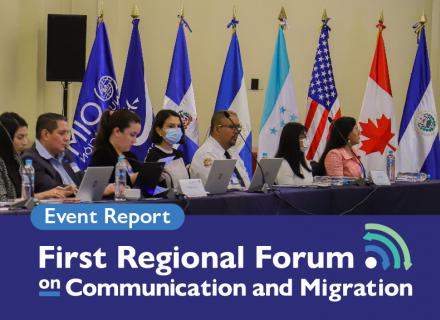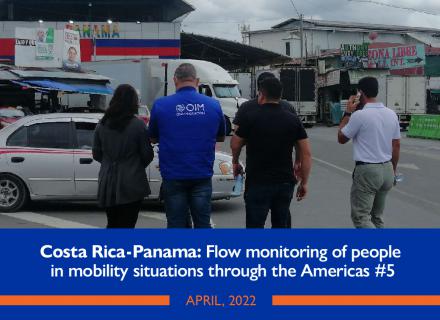LIBRARY
In our Library, you can find publications containing our research, workguides and other materials generated by the Western Hemisphere Program and IOM. You will also find information materials about our tools and campaigns and reports on our work.



Regional Guidelines for the Preliminary Identification of Profiles Referral and Mechanisms for Migrant Populations in Vulnerable Situations
These Guidelines are an instrument to facilitate the Member States of the Regional Conference on Migration (RCM) to carry out processes for the preliminary identification of profiles, attention and protection, as well as to take preventive actions in preparation for potential new migratory flows, as well as the referral of migrants and refugees in conditions of vulnerability within migratory processes.

Information and Communication Technologies and Migrant Smuggling in Central America, Mexico, and the Dominican Republic
This research provides an overview of the use of information and communication technologies (ICTs) in the facilitation of migrant smuggling operations in Central America, Mexico, and the Dominican Republic. At the same time, it provides concrete recommendations to address challenges and to include the use of ICTs in the prosecution and execution of actions to combat this crime.

Invisible Movements: Recommendation for Facilitating the Cross-Border Migration of Indigenous Peoples in the Caribbean
In 2020, there were approximately 281 million international migrants in the world, representing 3.7 per cent of the global population. Moreover, migrants who belong to historically marginalized groups are often at risk of discrimination, stigmatization, violence, or difficulty accessing assistance when mobilizing across country borders, especially when they have an irregular immigration status. Indigenous populations in the Americas and the Caribbean are an example of such a group that faces obstacles to their regular and humane migration conditions. Therefore, IOM conducted this study to examine the situation of cross-border movement within the region among indigenous peoples. This study focuses on the policies and legislation affecting the cross-border mobility and migration of indigenous peoples in the Caribbean. Using a human rights approach based on principles enshrined in regional and international instruments, it analyses specific case studies in different countries to provide examples of good practices, limitations, and opportunities for improvement.

Event Report: First Regional Forum on Communication and Migration
The International Organization for Migration (IOM), in coordination with the Pro-Tempore Presidency (PPT) of the Regional Conference on Migration (RCM) and the Working Group on Irregular and Mass Migration held the First Regional Forum on Communication and Migration in order to highlight the strategic role of communication in the management of migration and compliance with the GCM.

Costa Rica - Panama: Flow monitoring of people in mobility situations through the Americas #6 (May 2022)
The flow of migrant population moving through the Americas continues to be high compared to previous years and, in the same way, May represents the month with the highest number of departures registered in the MRS Los Planes, Chiriqui, equivalent to 42 percent of the records for the year. Between January and April 2022, 18,164 people registered their departure from the MRS Los Planes and the consequent entry into Costa Rica, while for May 2022 the registration is 13,248 people. Due to accessibility and language issues, there is an over representation of the surveyed population of Venezuelan nationality, therefore, the characteristics of the people surveyed were not extrapolated to all the people counted in the departure records.

Costa Rica - Panama: Flow monitoring of people in mobility situations through the Americas #5 (April, 2022)
Between December 2021 and April 2022, an increase of 71 percent of the population originating from the Bolivarian Republic of Venezuela is identified. On the other hand, there is a route from Venezuela to Colombia, mainly to Medellin, and from there, directly to Panama. Download the report to discover other trends.

Mexico - Flow monitoring of migrants in Tapachula and Tenosique, Round 1 (March 2022)
Tapachula (Chiapas) and Tenosique (Tabasco) are the main receiving cities for migrants on the southern border of Mexico. 2021 saw record breaking numbers of migrants entering Mexico through the southern border according to the Mexican Commission for Refugee Assistance (COMAR), which reported 89,636 applications for recognition of refugee status in Tapachula and 7,153 applications in Tabasco. IOM started monitoring the situation in these cities in March 2022.

Costa Rica - Panama: Flow monitoring of people in mobility situations through the Americas #4 (March, 2022)
This report shows that the number of people in the migratory flow continues to be stable. In March, 4.837 migrants were detected departing from Panama (just an 8% increase regarding February 2022). The tendency to heat North America as a final destination continues, the Venezuelan and Cuban people are choosing the United States, while Haitians are choosing Mexico.






